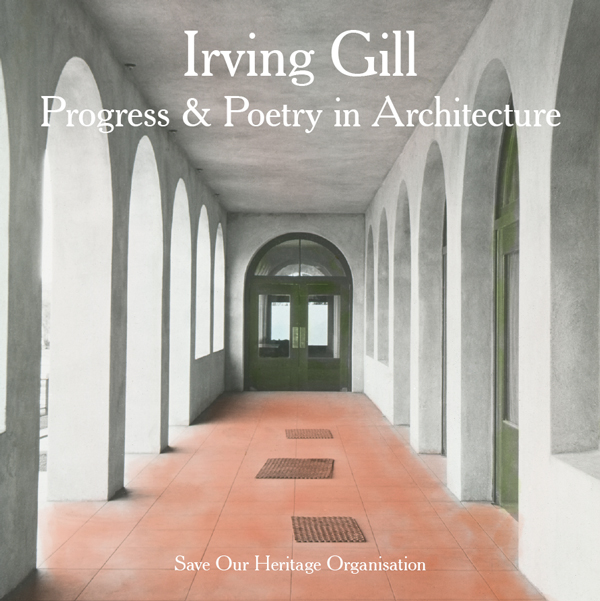|
The Essence of Irving Gill
October 2016
By Bobbie Bagel
 |
This catalog is a small gem! Thoughtfully curated and beautifully designed, it portrays the most important and intriguing aspects of Irving Gill's genius. The spare dedication reads: "to the straight line, the arch, the cube, and the circle." This introduces readers to Gill's minimalist sensibility-even before they reach the table of contents. And the book's square shape references the architect's early cubist leanings. The catalog complements the exhibition on display at the Marston House Museum. Irving Gill: Progress & Poetry in Architecture is part of a current regional Gill retrospective sponsored by twelve cultural organizations.
The first section of the catalog highlights the Marston House with excellent color photographs by Sandé Lollis. Co-editor Ann Jarmusch describes the stunning entry hall of the house. The wide oak door opens into a corridor of warm redwood paneling. Soft diffused light pours through the French doors at the far end of the hallway, giving the entire space a gentle glow, welcoming guests into the home. It is one of the most charming features of the house.
The architect's emphasis on labor-saving devices for minimizing housework and improving sanitation are also noted. Jarmusch cogently comments that "this duality-elegance and practicality-are what make Gill's mark on the Marston House so enduringly appealing."
Unseen for almost 100 years, rare glass slide photographs of Gill's work from the 1910 era make up the second section of the catalog. Eighteen of these delicate images are reproduced, and 41 are on display in the museum exhibit. Glass slides were originally viewed through a device called a magic lantern, a leading technology in its day. These images, some black and white, others gently hand tinted, are especially well suited to express the intricate play of light and shadow that defines Gill's work.
A dramatic photo of the Wheeler Bailey house perched on a cliff edge facing the Pacific Ocean introduces the third section of the book. It features rare pieces of furniture designed by Gill for this extraordinary home. A rough hewn, earthy dresser, and chairs covered in spotted cowhide are a far cry from the likes of Frank Lloyd Wright and the Greene Brothers, Gill's contemporaries. Erik Hanson, a Gill expert (and co-editor of the catalog) notes, "This furniture was put together like a house carpenter would build it. There's no Arts & Crafts joinery or craftsmanship of any sort." And yet, it blends in perfectly well.
The Reynolds family, relatives of the original owner, still lives in the landmark home, and is safeguarding the pieces as well as the architecture. The furniture display in the Wheeler Bailey room will surely be one of the highlights of the Marston House exhibit.
The fourth part of the catalog features Hanson's unique historic postcards of Gill architecture. It is the largest known collection, eighty cards in all. Thirteen are published in the book, and twenty-eight are on display in the museum. Dating from 1900 to 1930, they provide a glimpse back at a quieter, more sedate city. Sold in local shops in that era, these cards show which San Diego buildings were popular and held in high regard.
Contemporary and period essays comprise the fifth and final segment of the catalog, and make up the majority of the narrative. Three essays are by Irving Gill. The Home of the Future was printed in The Craftsman magazine, May 1916 edition. He paraphrases Victor Hugo, writing: Architecture "is the great book of the world, the principal expression of man in his different stages of development…Down to the time of Gutenberg,… architecture was the principal, the universal writing. Whoever was born a poet then, became an architect."
It is a wonderful insight into Gill's philosophy. In that same essay, Gill explains his reasoning in favor of minimalist design. He states, "Any deviation from simplicity results in a lack of dignity." Those ten words express most of what you need to know about Irving Gill.
The rest can be gleaned from Esther McCoy's ground-breaking essay also reprinted in this section of the catalog. It is from the renowned architecture critic's book, Five California Architects. First published in 1960, the volume had been out of print for many years until the respected Los Angeles art and architecture book store Hennessey + Ingalls reprinted it. It is again out of print, but with their generous permission, SOHO was able to present this chapter for Gill enthusiasts in this format.
The three contemporary essays in this section are written by local architects and professionals. They focus on Gill's remarkable use of color and texture, his interest in innovation and progressive housing for working families, and finally a brief memoir by an artist who had the unique experience of living in three different Gill homes.
This catalog deserves a serious read, not just a casual glance at the very appealing visuals. It is all right there: Irving Gill, the essence of a great architect, like poetry.
Published by Our Heritage Press
Paperback - 148 pages
$22.99
|
2025
2024
2023
2022
2021
2020
2019
2018
2017
2016
2015
|




